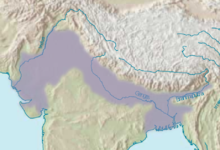Hindi Belt

The Hindi Belt or Hindi Heartland is a linguistic region in North and Central India where Hindi languages are widely spoken, either as primary or secondary languages.[1] [2][3] It is sometimes also used to refer to states whose official language is Hindi.
Regional definition
Sometimes it is also used to refer to states whose official language is Hindi. It is not necessary that their mother tongue is Hindi. For instance in Rajasthan people speak Rajasthani language which has roots in Old Gujarati and to communicate with outsiders they use Hindi. In Bihar people speak Bhojpuri, Magahi, Bengali and Maithili. In Haryana people speak both Hindi and Punjabi. In Himachal Pradesh people know both Hindi and Pahari. In Madhya Pradesh, large number of people speak Hindi and second most important common language is Marathi.[4][5][6].Other common languages include Malwi, Punjabi and Sindhi.[7] It is also interesting to note that people from these states are mostly bilingual. For instance large population in Bihar speak both Hindi and Maithili and there is a significant population which is well versed in English making them bilingual & multilingual. [8][9] With the influence of English people are becoming multilingual.[citation needed]
Constituent regions
The Hindi belt is often considered as covering the following states of Northern Indian region were Hindi is spoken[10],[11],[12]:
- Bihar
- Uttar Pradesh
- Madhya Pradesh
- Haryana
- Rajasthan
- Himachal Pradesh
- Uttarakhand
- Chhattisgarh
- Jharkhand
| State | Native Language |
|---|---|
| Bihar | Bhojpuri, Magahi, Bengali and Maithili. |
| Uttar Pradesh | Hindi |
| Haryana | Hindi, Punjabi and Rajasthani language in some parts |
| Rajasthan | Rajasthani language |
| Himachal Pradesh | Pahari |
| Uttarakhand | Kumaoni, Garhwali, Hindi |
| Chhattisgarh | Chhattisgarhi language, Hindi |
| Jharkhand | Santali language, Hindi |
The Union Territory of Chandigarh and the National Capital Territory of Delhi also lie in this belt.
The states of Indo-Aryan languages Gujarat, Maharashtra, Orissa, West Bengal and Jammu and Kashmir are equally familiar with Hindi, but are not regarded as a part of the Hindi belt for their official language is not Hindi but one of the other Indo-Aryan languages .
Demography
The heartland supports about a third of India's population and occupies about a quarter of its geographical area. The population is concentrated along the fertile Ganges plain in the states of Uttar Pradesh, Madhya Pradesh, Chhattisgarh, Jharkhand and Bihar.
Although the vast majority of the population is rural, significant urban cities include Chandigarh, Panchkula, Delhi, Lucknow, Kanpur, Jaipur, Agra, Varanasi, Indore, Bhopal, Patna and Ranchi. The region hosts a diverse population, with various dialects of Hindi being spoken along with other Indian languages, and multi-religious population including Hindus, Muslims, Sikhs, Christians along with people from various castes and a significant tribal population. The geography is also varied, with the flat, alluvial Gangetic plain occupying the northern portion, the Vindhyas in Madhya Pradesh demarcating the southern boundary and the hills and dense forests of Jharkhand and Chhattisgarh separate the region from West Bengal and Orissa.

Location and Geography
The heartland is located in North and Central India. The highly fertile, flat, alluvial Gangetic plain occupies the northern portion, the Vindhyas in Madhya Pradesh demarcate the southern boundary and the hills and dense forests of Jharkhand and Chhattisgarh lie in the east.
Climate
The region has a predominantly sub-tropical climate, with cool winters, hot summers and moderate monsoons. The climate does vary with latitude somewhat, with winters getting cooler and rainfall decreasing. It can vary significantly with altitude, especially in Jharkhand and Chhattisgarh.
Political Sphere
Over years political development in some of these states are dominated by caste based politics. In several parts, upper caste people had greater hold on political life of common people. But this trend has changed in recent years.[13]
References
- ^ B.L. Sukhwal (1985), Modern Political Geography of India, Stosius Inc/Advent Books Division,
... In the Hindi heartland ...
- ^ Stuart Allan, Barbie Zelizer (2004), Reporting war: journalism in wartime, Routledge, ISBN 0415339987,
... located in what is called the "Hindi heartland" or the "Hindi belt" of north and central India ...
- ^ B.S. Kesavan (1997), Origins of printing and publishing in the Hindi heartland (Volume 3 of History of printing and publishing in India : a story of cultural re-awakening), National Book Trust, ISBN 812372120X
- ^ Madhya Pradesh
- ^ Madhya Pradesh
- ^ Facts about Marathi language
- ^ Indore Culture
- ^ Maithili linguistic research
- ^ Language, Religion and Politics in North India By Paul R. Brass
- ^ http://www.accessmylibrary.com/coms2/summary_0286-2806514_ITM
- ^ http://www.indianexpress.com/oldstory.php?storyid=78641
- ^ http://www.123exp-geography.com/t/18624429910/
- ^ The Rise of the OBC in Hindi Belt
External links
